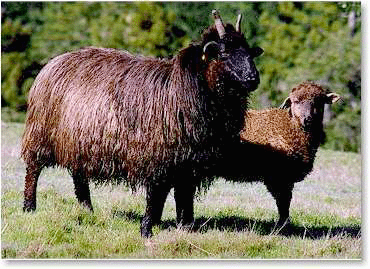An Endangered Breed

As early as 1789, the Spanish controlled the export of ewes from
the provinces of New Mexico to maintain breeding stock. But in
the 1850's thousands of Churro were trailed west to supply the
California Gold Rush. Most of the remaining Churro of the Hispanic
ranches were crossed with fine wool rams to supply the demand
of garment wool caused by the increased population and the Civil
War. Concurrently, in 1863, the U.S. Army decimated the Navajo
flocks in retribution for continued Indian depredations. In the
1900's further "improvements" and stock reductions were imposed
by U.S. agencies upon the Navajo flocks. True survivors were to
be found only in isolated villages in Northern New Mexico and
in remote canyons of the Navajo Indian Reservation.
Restorations of the Breed
In the 1970's several individuals began acquiring Churro phenotypes
with the purpose of preserving the breed and revitalizing Navajo
and Hispanic flocks. Criteria for the breed had been established
from data collected for three decades by the Southwestern Range
and Sheep Breeding Laboratory at Fort Wingate, New Mexico. Several
flocks have developed, and the Navajo Sheep Project has introduced
cooperative breeding programs in some Navajo and Hispanic flocks.
Conservation
The Dine’ were initially responsible for saving the "old type"
sheep from extinction. Navajos successfully maintained original
flocks in isolated areas where no other sheep breeds were introduced.
Sheep meat, milk for yogurt and wool for textiles sustained the
Dine’ for centuries. Even today, "Sheep is life," is a strong
belief in traditional Navajos.
In 1934 the U.S. Department of Agriculture established the Southwestern
Sheep Breeding Laboratory at Ft. Wingate, New Mexico to determine
what sheep might thrive in that region. They assembled some "original
old-type" Navajo sheep from local flocks and for 30 years introduced
fine wool breeds and long wool breeds. They concluded that the
best wool for the weavers and the sheep most suitable for the
high desert were the "old type".
By 1977, the "old type" Navajo sheep had dwindled to less than
500 head so Dr. Lyle McNeal formed the Navajo Sheep Project to
revitalize this breed and keep it from further depletion. Through
the efforts of individuals such as Ingrid Painter, Dr. McNeal,
Antonio Manzanares, Maria Varela, Goldtooth Begay, Dr. Annie Dodge
Wauneka, Milton Bluehouse and Connie Taylor with the assistance
of conservancies such as the CS Fund and American Livestock Breed
Conservancy and Ganados del Valle, the Navajo-Churro Sheep Association
was formed in 1986. There are currently over 4,500 sheep registered
with the N-CSA, an estimated 1,500 on the Navajo Reservation and
several hundred undocumented sheep in the U.S., Canada and Mexico.
Breed standards were developed for conformation and wool characteristics
using historic records, oral descriptions from Navajo Elders,
the contemporary Spanish churra and research from the Ft.Wingate
project. This included objective measurements by USDA scientists
and subjective observations of the samplers woven and dyed by
Navajo weavers employed at Ft. Wingate. Individual breeders located
sheep sifted from the remnant flocks of the Southwest and West
Coast and a few sheep still existed at UC Davis in California.
"Wanted Posters" were used by Dr. McNeal’s Navajo Sheep Project
to increase awareness of the breed and to locate old type sheep
for a revitalization of the nearly extinct breed. Historic standards
were applied to the existing nucleus of all the "old type" sheep
that were located.
In 1986, the N-CSA began registering Navajo-Churro based on phenotype.
The registry process is vital to maintaining standards and providing
breeders a network of pedigree information. Even though standards
are used, there is an attempt to maintain the diversity within
this landrace population. Each sheep registered must be "seen"
and approved by on site inspection or by mail in photos and fleece
samples. All progeny must be inspected for registration, even
if parents are registered. The inspectors must have competence
in sheep and wool. Several on the team are university professors
or County Extension Agents who specialize in sheep. The flock
book remains open to all conforming sheep even if they lack pedigree
information.
Inbreeding is not a problem except in a few flocks. Committed
breeders pay attention and share transportation expense to long
haul stock. Genetic relationships for 2,845 sheep were calculated
by Harvey Blackburn, U.S.D.A. to calculate inbreeding levels for
individuals and for flocks. The average for the population was
3.8% in three generations and increasing. A few flocks had levels
of 10.5%. Breeders often refer to "A Conservation Breeding Handbook"
by ALBC for advice on sound breeding schemes for small populations.
For Detailed information with great color photographs, download the "Guide to the Selection of Navajo-Churro Sheep" - click here for a PDF.
 .....
.....